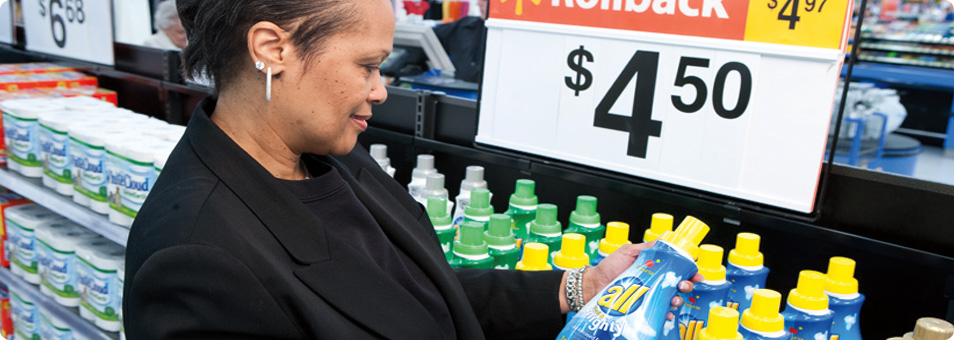
Home Goods
We believe that the products our customers use in their homes should be affordable and safe. We also believe that those products can be sustainable.
Detergent and Soap
Americas
United States
In late 2007, we committed to transition our entire liquid laundry detergent category to concentrated detergent by May 2008. We saw success in this initiative when Unilever developed its all® small-and-mighty detergent, which is onethird the size of the 100-oz. bottle. This new detergent can wash just as many loads of laundry and is easier for customers to carry. In 2007 and 2008, we worked with all of our major detergent suppliers, and every detergent brand made the switch. We expect that by 2011 this change will save more than 125 million pounds of cardboard, 80 million pounds of plastic resin and 430 million gallons of water. These changes help us save money on diesel needed to transport the improved bottle. This commitment also resulted in real savings for our suppliers.
Our Americas region also is taking steps to make its laundry detergent category more sustainable. By 2012, all of the liquid laundry detergent sold there will be at least two times concentrated to reduce water use. In addition to working with suppliers to increase the amount of compact versions of laundry detergent they offer, we have committed to reducing phosphates in detergents being sold in the region. We will require our suppliers to reduce phosphates by 70 percent in laundry and dish detergent by 2011 based on a 2009 baseline. We will measure this goal by calculating the total mass of phosphate content in detergents sold in the Americas per year.
Brazil
One unique product being sold in Wal-Mart Brazil stores is the private-label TopMax bar soap, which is made from used kitchen oil that Wal-Mart customers deposit into oil collection receptacles in stores. The soap is biodegradable and also phosphate-free.
Wood and Paper
Another area where we believe we can make great strides is in our wood supply chain.
Americas
United States
In 2008, we committed to eliminate wood that comes from unwanted sources from our supply chain by July 2013. In order to do this, we partnered with the World Wildlife Fund's Global Forest and Trade Network (GFTN). The GFTN aims to eliminate illegal logging and improve the management of valuable and threatened forests. Together with the GFTN and its network and expertise in 36 countries, we will work with our suppliers to improve the traceability and transparency of our wood and paper supply chain and move toward even more sustainable sourcing.
Asia
China
In addition to our work with the GFTN, we are focusing a great deal of attention on our wood product procurement from China. China is an important source of products manufactured from wood, and therefore it's important for our Company and our suppliers to gain greater transparency into this portion of our supply chain. Wal-Mart Stores, Inc. recently entered into a memorandum of understanding with the Chinese National Forestry Industry Association to build relations with the organization and gain visibility into their new wood certification process. We will work alongside them, offering our thoughts on their certification process, learning how they are developing their standards, the source of the information they are using as new certified forests come on line, and how they are documenting the timber supply chain.
Chemicals
With thousands of products on our shelves that contain chemicals, identifying which chemicals may be harmful is, without question, a challenging task. One of our goals is to drive the development and sale of products that are better for the environment and for our health. To help reach this goal, we developed an internal team that identifies chemicals of concern and encourages suppliers to explore and bring to market products that contain alternatives to the chemicals we identify. By working closely with our suppliers, we are tackling this challenge and seeing progress.
Americas
United States
In our 2007 report, we discussed plans to identify 20 chemicals of concern that we would work to eliminate from products sold at our stores. Since that time, we believe we have found a more effective way to address this issue and provide our customers with products that are environmentally preferable. By working in a collaborative process with the members of our Chemicals Sustainable Value Network, we have identified a screening tool, called GreenWERCS, that will provide us with a far more comprehensive view of the products we sell than methods we previously identified. GreenWERCS will help us analyze the products on the market and identify risks across a broad spectrum instead of looking at each chemical individually.




